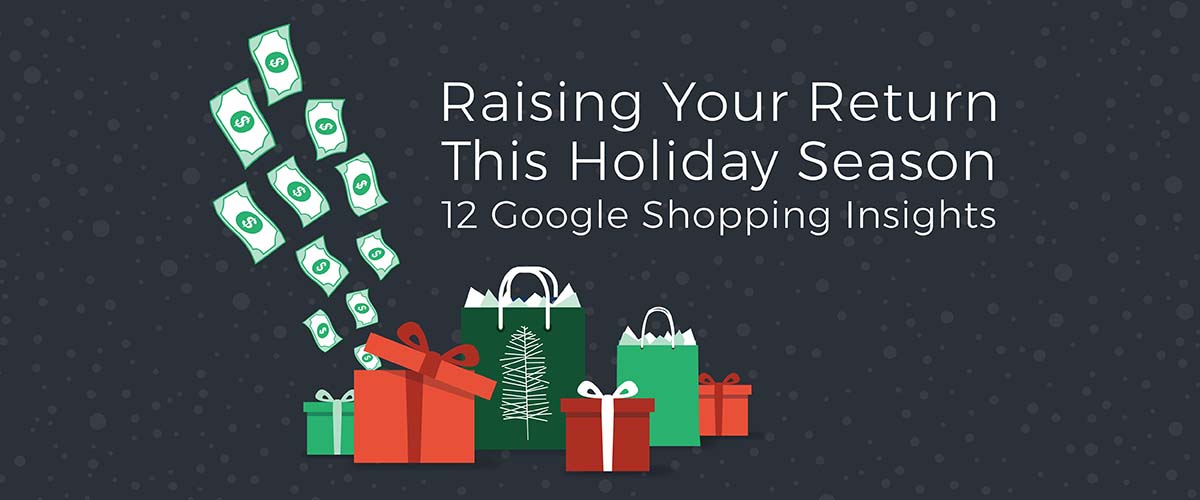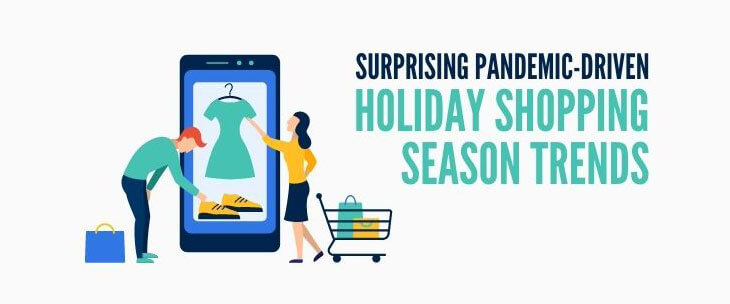It would be an understatement to say it’s important to prepare your Google Shopping account for the ever-profitable holiday season. Unfortunately, many businesses struggle to run campaigns that take full advantage of the season’s potential, missing out on valuable opportunities to reach new customers and raise their returns. Instead of reading tea leaves or visiting a medium, businesses should be looking at past years’ data to get a better idea of how this season will go.
Set yourself up for success with these 12 Google Ads insights that will make this holiday season your best yet.

Think Beyond Black Friday
Everyone knows that once the table has been cleared of whatever remains from Thanksgiving dinner, the holiday shopping season has officially begun. While it is true that there’s a lot of money to be made between Black Friday and Cyber Monday, businesses need to formulate a plan of action for the entire holiday season.
1. “Only about 18% of shoppers consolidate all of their shopping to the Black Friday-to-Cyber Monday weekend, and by the Black Friday-Cyber Monday period, shoppers have already completed 42% of their holiday shopping.”1
Ignoring the fact that the majority of holiday season purchases occur after Cyber Monday could result in the loss of a large chunk of business. Contrary to what you might believe, online sales start picking up as the calendar creeps toward December 25th.
2. “Online conversions from the week before December’s shipping cutoff date [are] on par with the week of Cyber Monday.”2
It seems that economical shoppers aren’t only looking to make purchases on the “unofficial” start of the season, Black Friday, but they are also waiting longer and longer to see savings. The holiday shopping season isn’t just extending further into November every year, but stores are also starting to see lucrative business all the way up until New Year’s Day.
3. In 2016 “about 20% of all observed December store traffic [happened] in the six days after Christmas alone.”2
There isn’t a “one size fits all” approach to Google Ads that will appeal to all types of holiday shoppers. To come up with some ingenious strategies that will pay off once the January slowdown rolls around, try putting yourself in the shoes of some of the customers you are vying for.

Plan for Patient Purchasers
Not every holiday shopper will be camping out in front of their local shopping mall waiting for the doors to unlock on Thanksgiving night. Some shoppers will hold out and bide their time until they find the perfect gift, or the perfect price.
4. “When shoppers consider a new purchase, they spend 13 days on average shopping for the item.”2
While it’s helpful to know how long people take to make a purchasing decision, it doesn’t tell the complete story — specifically, what mediums they utilize when shopping. In addition to spending, on average, 13 days considering a purchase, shoppers are also browsing for products across multiple avenues.
5. According to last year’s data, “76% of U.S. holiday shoppers over 18 use three or more channels.”1
Strategizing for shoppers who take a little longer to convert will open up your business to receive sales that could have otherwise gone to your competitors. But these aren’t the only customers you should keep in mind when planning for the holiday season.

Brace Yourself for Stragglers
We all know someone who always waits until the last second to shop for the holidays. Year after year there are people who don’t start buying presents until the week before the big day, or even later. For the last minute shoppers who waited until after the shipping cutoff date has passed, their only hope is finding any store that’s open.
6. “Searches for ‘where to buy’ peak on Dec. 23 as last-minute shoppers grab their final gifts and stocking stuffers.”2
Holiday shopping procrastinators feel the crunch to wrap up their purchases quick, but aren’t too concerned with getting a good deal. For those shoppers, fast shipping will be a major factor when choosing which business to buy from.
7. “Mobile searches related to “same-day shipping” have grown 120% since 2015.”2
Planning ahead only for the proactive shopper will result in your business ignoring the needs of another class of shoppers: the unprepared. There isn’t a good enough excuse not to cast a wide net this holiday season to try and maximize your bottom line. And, while online shopping might appear to be most people’s preferred method of purchasing nowadays, it plays to your advantage to strategize for those who still prefer to buy their products in person.

Acknowledge Brick-and-Mortar Holdouts
Not everyone is comfortable making big purchases online. These people might worry the product won’t arrive as they expected it to or they would just rather see it in person before deciding. While these people may not, at first glance, seem like a demographic worth pursuing, they can be an extremely valuable audience for businesses selling both in-store and online.
8. “61% of shoppers would rather shop with brands that also have a physical location than ones that are online only.”3
Since catalogues have stopped serving as a primary source of gift inspiration, people have turned to Google. Even if they’d rather actually make a purchase in-person, a clear majority of these shoppers browse online prior to heading to a physical location.
9. “78% of holiday shoppers who visited a store turned to online search before going into a store.”3
Although it is difficult to track, your online ads do in fact lead to in-store purchases in addition to website conversions. While it isn’t necessary to create ads that cater exclusively to this demographic, you should highlight physical location details in your ads to make them more appealing. If you want to go beyond that, consider other tactics you could employ to get people through the door.

Strengthen Your Mobile Approach
Due to the seamless shopping experience mobile phones provide now, people can start shopping on a desktop computer, continue on their smartphone, then go to a store’s physical location. If you’d like to profit from mobile users in your area, think about implementing location targeting within your ads to encourage shoppers to stop by.
10. “Searches for “shopping near me” have grown over 200% in the past two years.”1
In addition to location targeting, you should consider how you can make your ads more relevant to shoppers. Think about what valuable information both your ads and your website could provide potential customers.
11. “80% of smartphone users are more likely to purchase from companies whose mobile sites or apps help them easily find answers to their questions.”4
It is clear that the demand for products online isn’t stopping anytime soon. While it may be too late to do anything about it this year, think about building an app to engage with a younger, more tech-savvy audience.
12. “Searches for ‘shopping app’ have jumped 90%, while searches for ‘online shopping’ have grown 180% in that same period.”1
As traffic shifts from the traditional desktop computer to the mobile landscape, make sure your digital marketing strategies don’t get left behind. Hitting both formats hard will help your business reach a larger audience.
Wrapping it up
This holiday season is stacking up to be the biggest one on record. But in order to make the most of the opportunity, you need to execute more effective campaigns on Google Shopping. For the strategies and best practices you need to make this holiday season your best yet, check our free Holiday Guide to Google Shopping!





